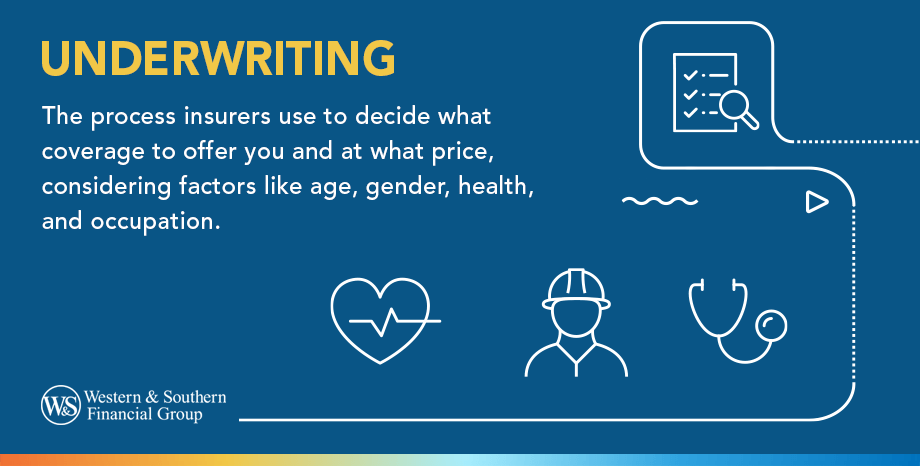Video Transcript
Ever wonder why two people the same age can pay very different prices for life insurance? The answer lies in underwriting—a behind-the-scenes risk check that shapes everything from your premium to your policy’s fine print. Underwriting is the insurer’s way of sizing up risk. Think of it as a financial and medical report card rolled into one. Your health history, lifestyle, and finances help an underwriter predict the likelihood—and cost—of a future claim. The better the risk, the better your premium.
There are two types of underwriting: medical and financial. Medical underwriting looks at your current health, prescriptions, and family history. A smoker or someone with unmanaged diabetes, for instance, might be assigned a rating with a higher degree of risk. Financial underwriting checks income, assets, and debt to confirm the coverage amount makes sense. If the numbers don’t align, the insurer may suggest a lower face amount.
Now meet the underwriter. Part detective, part statistician, the underwriter balances your need for coverage with the company’s need to stay solvent. They can approve your application as-is, approve it with tweaks such as higher premiums or specific exclusions or lastly simply decline if the risk is too high.
Here is a look at the process. Review your submitted application. This includes personal, health, and financial details. Then an initial review which includes basic checks for completeness and noting any possible red flags. A risk assessment. The underwriter will take a deep dive into your medical records, lifestyle habits, and financial stability. Extra information may be requested. You might be asked for a brief exam, blood work, or an attending physician statement. Decision time. Here is where you will get an approval including a rated policy with possible exclusions or reject the application if the potential risk is deemed too high. The policy is then issued where you will sign, pay the first premium, and your coverage goes live. Lastly, ongoing monitoring – Some high-value policies require periodic updates.
All of this matters to you because underwriting will determine the following: first of all your premiums. Higher risk equals higher cost. Secondly your coverage. If you are asking for too much coverage without matching income, expect an adjustment. And lastly your policy terms. Exclusions for hazardous hobbies or certain medical conditions keep the policy sustainable.
Some helpful ways to navigate underwriting include being transparent. Honest answers speed things up and avoid surprises later. Prepare your documents. Gather medical records and financial statements in advance. And lastly, stay healthy. Small lifestyle tweaks—like quitting smoking—can drop premiums.
Underwriting may sound intimidating, but it’s simply the insurer doing its homework. Know the process, provide accurate information, and you’ll be well positioned to secure coverage that fits your budget and your life. For more guidance—or a free life insurance quote—visit WesternSouthern.com today.
Key Takeaways
- Underwriting is the process insurers use to assess risk and determine policy terms.
- Medical and financial underwriting are common types used in life and health insurance.
- Underwriters play a crucial role in risk assessment, decision-making, and policy structuring.
- The underwriting process involves application submission, risk assessment, decision-making, and policy issuance.
- Confidentiality of the provided information is ensured, and privacy regulations are strictly followed.
What is Underwriting?
Underwriting is a critical process in the insurance industry where life insurance companies evaluate the risk of insuring a person and determine the terms of coverage. This process involves assessing various factors such as the applicant's health, financial status, family health history, and lifestyle to decide if they are insurable and at what premium rate.


Types of Underwriting
Medical Underwriting
Medical risk underwriting involves evaluating an applicant's health and medical history to determine their insurability and the terms of coverage. This type of underwriting is commonly used in life, health, and disability insurance.
Example: For a life insurance application, the underwriter may review the applicant's medical records to check for conditions like heart disease, diabetes, or other health issues. If the applicant is a smoker, the underwriter might assign the life insurance classification rating as a higher degree of risk, resulting in higher premiums or specific policy exclusions.
Financial Underwriting
Financial risk underwriting involves evaluating an applicant's financial status to determine their ability to pay premiums and the appropriateness of the coverage amount. This type of underwriting is commonly used in life insurance, disability insurance, and business insurance.
Example: For a high-value life insurance policy, the underwriter may review the applicant's income, assets, and debts to determine if the coverage amount is justified. If an applicant has a significant amount of debt and unstable income, the underwriter might approve a lower coverage amount or request additional financial information.
Begin your insurance application with confidence. Get a Free Life Insurance Quote
The Role of the Underwriter
A life insurance underwriter plays a pivotal role in the insurance industry, acting as the gatekeeper between the applicant and the insurer. Their main role is to assess risk and determine whether to offer insurance coverage and, if they do, under which conditions. Here are the key functions and responsibilities of an underwriter:
Insurance Risk Assessment
Underwriters assess the level of risk associated with insuring an individual or asset. They examine various factors such as personal and family medical history, financial stability, lifestyle habits, and other relevant data. By evaluating these factors, underwriters estimate life expectancy and determine the likelihood of a claim being made and the potential cost to the insurer.
Decision Making
Based on their risk assessment, underwriters make critical decisions about insurance applications. They decide whether to:
- Approve the application and issue a policy.
- Approve with modifications, such as higher premiums or specific exclusions.
- Reject the application if the potential risk is deemed too high.
Policy Structuring
When approving a policy, underwriters determine the terms and conditions, including the coverage amount, premium rates, and any exclusions or limitations. They ensure that the policy is structured to balance the insurer’s need to manage risk with the applicant’s need for coverage.
Review and Analysis
Underwriters continuously review applications and policies to ensure accuracy and compliance with industry standards and regulations. They analyze trends and data to improve underwriting guidelines and procedures.
Collaboration
Underwriters often work closely with agents, brokers, and other insurance professionals to gather additional information and clarify details about the applicants. They also communicate with policyholders to explain underwriting decisions and answer questions.
Ongoing Monitoring
After a policy is issued, underwriters may monitor the policyholder’s status and adjust coverage or premiums as necessary. This ongoing assessment helps manage risk over the policy's life.
Staying Informed
Underwriters stay updated on industry developments, regulatory changes, and emerging risks. This knowledge allows them to make informed decisions and adapt to the insurance industry's evolving landscape.
Underwriters are essential to the insurance process, ensuring that policies are issued responsibly and sustainably. Their expertise and judgment help balance the interests of both the insurer and the insured, providing a foundation for effective risk management.
Understanding the Life Insurance Underwriting Process
1. Application Submission
The underwriting process begins when an applicant submits a life insurance application form. This application includes personal information, medical history, financial details, and other relevant data.
2. Initial Review
Upon receiving the application, an underwriter conducts an initial review for completeness and accuracy, which may involve cross-referencing with external databases and performing preliminary checks.
3. Risk Assessment
The underwriter assesses the risk associated with insuring the applicant and assigns a life insurance risk class. This involves evaluating several factors, including:
- Health History: Reviewing medical records, conducting health exams, prescription medication records, and considering any pre-existing conditions or family history.
- Financial Stability: Analyzing income, debts, credit history, cash flow, and overall financial health to gauge the applicant's ability to pay premiums.
- Lifestyle Factors: Considering habits and behaviors such as smoking, alcohol use, occupation, driving record, and risky hobbies that might impact risk levels.
4. Additional Information Requests
While the application is our first source of information, additional items may be needed to complete the underwriting process. If necessary, the underwriter may request a life insurance medical exam or additional information from the applicant.
Only information directly relevant to the risk is requested, and we will always seek approval from the policy owner and/or proposed insured person to conduct any tests and provide additional information.
These may include:
- Medical Exam: A medical professional or physician will record your medical history, measure your height, weight, blood pressure, and pulse, and obtain a urine sample.
- Blood Test: Examples of screening tests include cholesterol, glucose, liver and kidney enzymes, and the presence of HIV antibodies.
- Resting Electrocardiogram (EKG): For certain conditions.
- Attending Physician's Statement (APS): A doctor's APS report detailing your medical history and insights can often enable us to offer more favorable coverage rates.
- Motor Vehicle Report
- Database Query: Medical, financial, and employment records
- Pharmacy Records: List of prescriptions and dosage amounts along with prescription history records.
- Financial Information: Such account information obtained from the policyowner or proposed insured, their accountant, or financial planner may be required for larger-amount insurance applications.
5. Underwriting Decision
Based on the gathered information, the underwriter makes an insurance underwriting decision on the application. The possible outcomes include:
- Approval: The life insurance applicant is deemed insurable, and a policy with specified terms and premium rates is offered.
- Rated Policy: The applicant is approved but with higher premiums due to elevated risk factors.
- Exclusions: Certain conditions or activities may be excluded from coverage.
- Rejection: The application is denied if the risk is deemed too high.
6. Policy Issuance
If the application is approved, the insurance policy outlines the type of policy, coverage details, premium amounts, death benefits, and any specific conditions or exclusions. The applicant receives the policy documents and begins coverage upon acceptance and payment of the initial premium.
7. Ongoing Monitoring
Underwriting doesn't end with policy issuance. Insurers may continue to monitor the policyholder's status to adjust coverage or premiums as needed. This could include periodic health evaluations or financial assessments to ensure the policy remains appropriately priced and structured.
Understanding the life insurance application process and underwriting process helps applicants prepare better and increases their chances of securing favorable insurance coverage. Being transparent and providing accurate information can streamline the process and lead to better outcomes.
Confused about underwriting? We can help you understand and navigate the process. Get a Free Life Insurance Quote
Impact of Underwriting on Life Insurance
Underwriting plays a crucial role in the insurance industry by assessing risk and determining the terms of coverage for applicants. The underwriting process's outcomes significantly impact the insurance company and the policyholder. Here are some key ways underwriting affects insurance:
1. Premium Rates
- Underwriting directly influences the life insurance rates an applicant will pay for their insurance policy. By assessing the risk associated with insuring an individual, underwriters set premium rates that reflect the likelihood of a claim being made.
- Higher-risk applicants (e.g., those with pre-existing medical conditions or hazardous occupations) are typically charged higher life insurance premiums to compensate for the increased risk.
2. Coverage Amount and Terms
- Underwriters determine the appropriate coverage amount based on the applicant's risk profile. This ensures that the insurance coverage is neither excessive nor insufficient relative to the applicant's needs and circumstances.
- Based on underwriting findings, specific terms and conditions, such as exclusions or limitations, may be applied to the policy. This helps manage risk by excluding certain high-risk factors from coverage.
3. Approval and Rejection of Applications
- The underwriting process results in insurance application approval, modification, or rejection. Applicants who meet the underwriting criteria are approved, while those with a risk too high may be denied coverage.
- In some cases, underwriters may approve an application with modifications, such as higher premiums, reduced coverage amounts, or specific exclusions.
4. Risk Management for Insurers
- Underwriting helps life insurance companies manage their risk exposure by ensuring that the policies they issue are appropriately priced and structured. This prevents the insurer from taking on excessive risks that could lead to financial instability.
- By carefully evaluating and categorizing risk, underwriters help maintain the insurer's profitability and ability to pay out claims.
5. Policyholder Trust and Transparency
- Transparent underwriting practices help build trust between the insurer and policyholders. When applicants understand how their risk is assessed and how premiums are calculated, they are more likely to feel confident in their insurance provider.
- Clear communication of underwriting decisions and policy terms fosters a positive relationship and enhances customer satisfaction.
Conclusion
The traditional underwriting process is fundamental to the insurance industry. It shapes applicants' terms, premiums, and availability of life insurance coverage. By evaluating risk and making informed decisions regarding life expectancy, underwriters ensure that insurance policies are fair, appropriately priced, and sustainable.
Understanding the impact of underwriting can help policyholders navigate the insurance application buying process more effectively and secure the best possible coverage for their needs. For more help understanding the underwriting process, consider speaking with a Life Insurance Agent.
Navigate your path to life insurance with clarity and confidence. Get a Free Life Insurance Quote
Frequently Asked Questions
What does it mean when insurance goes to underwriting?
When insurance enters the underwriting phase, the insurer evaluates the applicant's risk to decide on coverage options and its conditions. This process involves examining personal, medical, and financial information to gauge the potential for a claim. The results can influence premium rates, coverage amounts, and policy terms.
How long does it take an underwriter to approve insurance?
The approval time for an insurance underwriter can vary significantly, usually from a few days to several weeks. This timeframe depends on the application's complexity, the type of insurance, and whether additional information or medical exams are required. Simple applications with complete information are processed faster, while more complex cases may take longer.



























